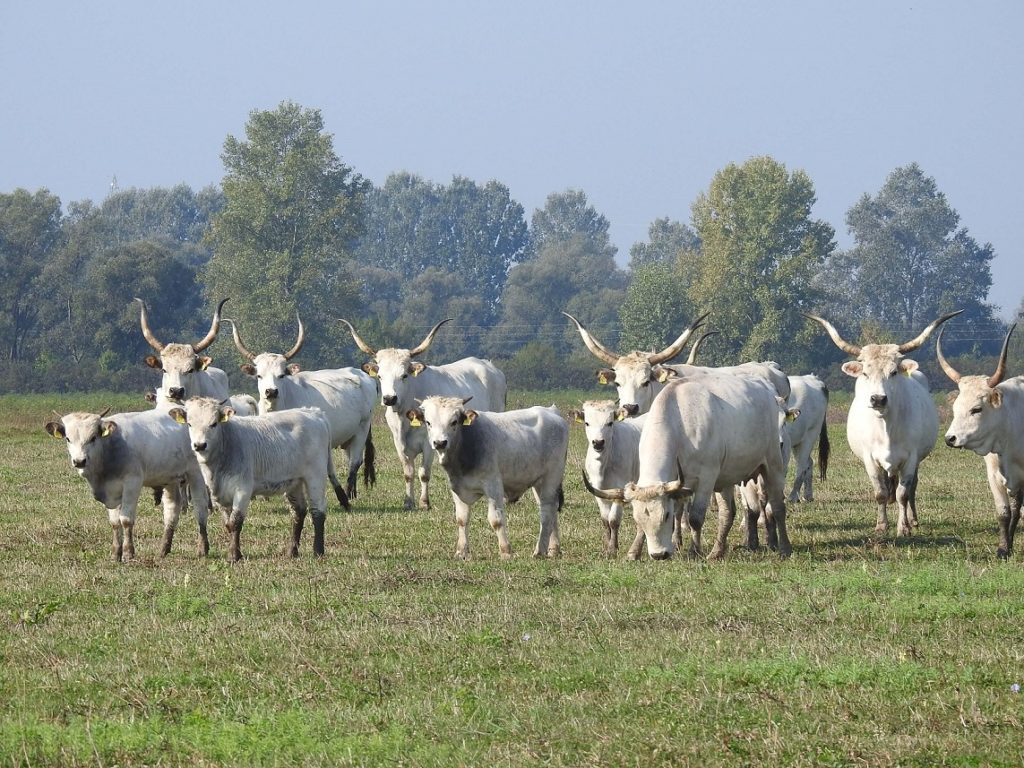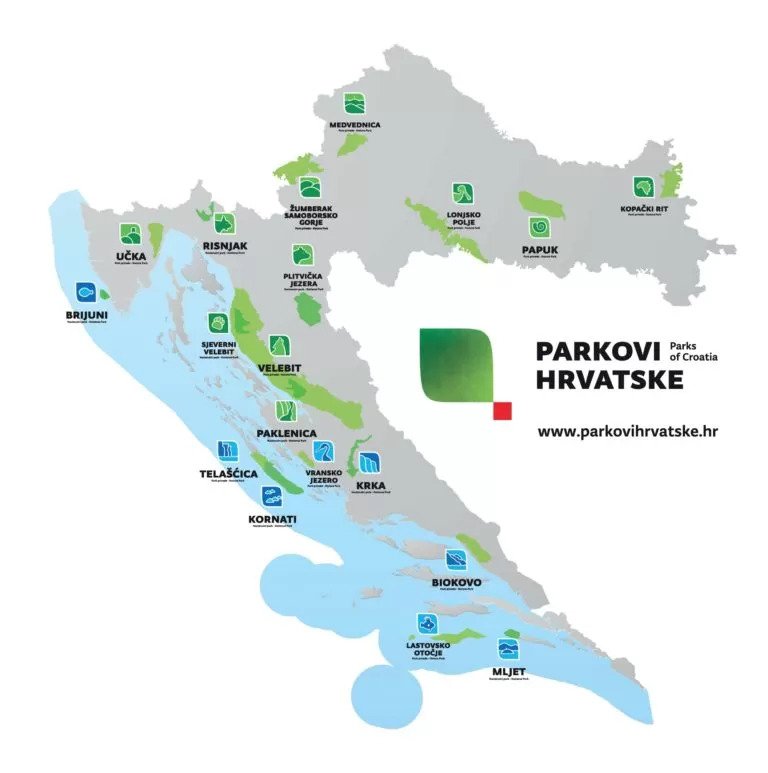Being one of the biggest and best-preserved natural floodplains in Europe, Lonjsko Polje is the third-largest nature park in Croatia. The Park’s floodplain fields and forests are habitats for more than two-thirds of all birds in Croatia.
This treasure trove of biological diversity only 70 kilometers south-east from Zagreb is perfect for a weekend escape.
- Welcome to Lonjsko Polje, Croatia’s third-largest nature park
- Why visit Lonjsko Polje Nature Park?
- Where is Lonjsko Polje?
- How to get to Lonjsko Polje?
- Activities: walking trails, birdwatching, boat rides, tractor rides, cycling
- Lonjsko Polje flora
- Lonjsko Polje fauna
- Eco-Ethno Village Strug
- Where to stay? Accommodation in Lonjsko Polje
- Where to eat? Restaurants in Lonjsko Polje
- Tickets and timetable
- Planning your visit
Welcome to Lonjsko Polje, Croatia’s third-largest nature park
Croatia has plenty of natural beauty, both on the coast and the continent. One such remarkable and protected nature area is Lonjsko Polje, a nature park that stretches along the Sava River’s middle course, from Sisak to Stara Gradiška.
Besides hiding many natural and cultural phenomena, the Park is also a favorite place for many excursionists. Animal lovers, prepare yourself to meet many protected species of birds and domestic animals.
Walking on educational trails, enjoying nature, birdwatching, cycling, and riding on solar-powered boats are just some of the activities that make it worthwhile to come to Lonjsko Polje.
Oh, and let’s not forget the excellent food offer. Traditional Posavina cuisine rich in river fish and venison will leave few indifferent.
Are you tired of the city crowds and want to forget about the many obligations that await you, even just for a day? Lonjsko Polje is waiting for you for a perfect break from the noise and city bustle in preserved nature.
Why visit Lonjsko Polje Nature Park?
Every year, the Sava River’s middle course and its tributaries flow into three fields – Lonjsko, Poganovo, and Mokro. These fields play a key role in the flood control system. Thus, they are one of the first examples of flood control based on natural floodplains – globally.
This periodic flooding thus enriches the Lonjsko Polje area’s biodiversity. However, local people’s traditional lifestyle makes this nature park so unique.
When floodwaters recede into the Sava riverbed, wet grasslands become one of the last areas in Europe where traditional grazing has been preserved. There the cattle graze freely on large common pastures.

Apart from traditional grazing, the tradition still preserved by the local population, Lonjsko Polje is a unique example of the traditional architecture of wooden oak houses.

Villages in Posavina are unique places of natural and cultural heritage worth admiring. One such is Krapje, a village with a status of architectural heritage that hides some houses older than 200 years!

This area is a habitat for more than two-thirds of all birds in Croatia. And within the Park is the first European Stork Village – Čigoč, best known for White Storks, one of more than 250 bird species living in the Park area.
Besides, Lonjsko Polje is one of the most crucial river fish hatcheries in the entire Danube basin. It is also a part of the Danubeparks project, which connects protected areas from nine Danube countries.

This year, Lonjsko Polje Nature Park celebrated its 31st birthday.
Where is Lonjsko Polje?
Lonjsko Polje Nature Park lays along the alluvial plain of the Sava River’s central course, between Sisak and Stara Gradiška. Its area of 50,650 ha is the largest protected wetland area in Croatia and one of the largest in the entire Danube basin.

Lonjsko Polje is in the Sisak-Moslavina County and has three visitor centers – Krapje, Čigoč, and Repušnica – and the fourth center in Osekovo named Crna roda (Black stork) will open its doors in 2021.

How to get to Lonjsko Polje?
Lonjsko Polje stretches south of the Croatian A3 motorway (European E70). You will probably notice traffic signs showing exits to Lonjsko Polje on the way.

From Zagreb to Lonjsko Polje, the distance is about 70 kilometers. So the easiest way is to take the A3 highway and exit at Popovača and drive to the village of Repušnica, where there is a reception center.
You can enter Lonjsko Polje Nature Park in one of the three visitor centers in Krapje, Čigoč, and Repušnica Villages. By exiting the motorway at Popovača, you can also get to the Čigoč Village, the first European Village of Storks, and enter the nature park.
The other way is to exit at Lipovljani or Novska and drive to the village of Krapje, where you’ll find the other Visitor Center. This way is also good if you’re coming from the direction of Slavonski Brod or Osijek.

If you decide to take a train from Zagreb (or Vinkovci), you can stop at Sisak, Novska, or Jasenovac’s railway stations. Park Administration can wait for you with bikes, from where you can take a leisurely bike ride to the Park.
Looking for a fast, reliable and trouble-free transfer to or from Lonjsko Polje? Contact TC transfer partner Adriatic Transfers for your one-stop solution.
Activities: walking trails, birdwatching, boat rides, tractor rides, cycling
The weekend family program is ideal for anyone who wants to skip the routine and enjoy nature. The program costs 50 kunas per person. For children from 3 to 6 years, the ticket is 5 kuna, and for children from 7 to 10, it is 15 kuna.
The price includes:
– Krapje Visitor Center (Krapje 16): walk along the footpath, a story about traditional architecture and sightseeing of Krapje, Krapje Đol Special Ornithological Reserve, ride on solar-powered boats and in a tourist train
– Repušnica Visitor Center (Fumićeva 184, Repušnica): walk along the hiking trails of Repušničko polje, Vrbačinec picnic area
– Čigoč Visitor Center (Čigoč 26): walk along the footpath, the story of the white stork (Sunday at 1 pm), sightseeing, walk in the retention of Lonjsko polje (Mužilovčica)
Due to limited capacity and great interest, please announce your ride on the tourist train and boat on +385 44 672 080.
Walking educational trails
Four walking trails that lead through the Park provide a view of wild and indigenous domestic animals’ species. They are Posavina horses, Turopolje pigs, and Slavonian-Srijem Podolian cattle.

Of the many exciting walking trails where you can observe cattle, the Staza graničara (Borderers’ Trail), starting from the Visitor Center Krapje, stands out. A walk along this trail also brings a breath of the past. Namely, the Military Frontier (Vojna Krajina) – the border between the Austro-Hungarian and Ottoman Empires – once stretched here, after which the trail got its name.

Today, two replicas of wooden historical watchtowers (čardaci) are symbolically built next to it.

Besides the mentioned Borderers’ Trail, you can also take the Posavina Trail, Košćeva Trail, and Tena Trail. The latter was named after the eponymous story by Josip Kozarac, a Croatian writer who spent ten years in the Lonjsko Polje Nature Park as the first manager of the Lipovljani Forest Department.
Birdwatching
Since the Park is home to over 250 different bird species, this is one of Croatia’s perfect birdwatching places.
Don’t miss to see the white stork in Čigoč, a European Stork Village. From spring to autumn, look above the numerous nests on the pillars around the village, and you’ll notice this white bird with a red beak.

You can also observe birds in the ornithological reserves Rakita and Krapje Đol. In the Krapje Đol Special Ornithological Reserve, the first and oldest Croatian bird reserve, you can see a spoonbill, the Park’s symbol.
Solar boat rides in Plesmo
Sailing on solar-powered boats has recently been Park’s special attraction. The boat ride gives you a discreet view of nature as it has been developing in and around the river for thousands of years.

Riding these silent boats through the Sava River, sightseeing the traditional grazing, animals, and birds is a memorable adventure worth your visit.

Due to the limited space, we recommend you schedule your ride in advance. The pier for solar-powered boats is in the village of Plesmo.
Tourist train
For an even more authentic experience, take a train ride from the Krapje Visitor Center to the pier in Plesmo. Yes, this important vehicle has been converted for tourist purposes. And from the train, you can sightsee the Lonjsko Polje in a particular perspective, just like the locals.

Besides solar-powered boats, tourist trains are also popular among visitors. Make sure to schedule your visit.
A slightly more modern option is offered in the Visitor Center Repušnica – golf carts. However, one of the most attractive vehicles is undoubtedly a tourist train. Every weekend until June 2021, the tourist train will wait for you in Krapje.
Come to Krapje, and the tourist train will depart you in front of the souvenir shop every full hour from 10 am to 4 pm. Start your journey through Lonjsko Polje with a train that takes you to the port of Strug, from where the solar-powered boat departs.
Cycling
If you want to have a pleasant and recreational stay, we recommend that you ride your bike through the Lonjsko Polje. The Park’s bike paths connect Posavina with Moslavina and Pounje. Since there are no climbs, they are easy and pleasant to ride.

Of course, you can also rent bikes in the villages of Krapje, Čigoč, and Repušnica. The daily rent is 80 kuna. The Park’s stuff can also deliver bicycles to the railway stations in Jasenovac, Novska, and Sisak, from where you can cycle to Lonjsko Polje. Isn’t that great?

Of all the bike trails, the most popular is the national route Sava (Posavina route). Check all bike trails here.
More boat rides
Besides the innovative solar-powered vessels, you can take a ride on the Vodomar ferryboat, a 15-meter-long raft still operating on the Sava River from Drenov Bok village. During the ride, you can see the attractive riverine landscape with a natural riverside – willows, poplars, and sandbanks.

For an unforgettable and authentic experience, take a ride on the traditional river-powered raft used in the past to transfer people and vehicles across the river. Two of those rafts still operate today for sightseeing.
Visitors can also get to know the historic center of Sisak and Posavina with an reconstructed boat Juran and Sofija, sailing on the Kupa River.

Lonjsko Polje flora
Due to the vast lawns and forests, all shades of green dominate in Lonjsko Polje. Lucerne oak and ash’s lowland floodplain forests represent the most deciduous forest complexes in the entire Western Palearctic.
As many as 550 plant species grow in the Lonjsko polje Nature Park. Some are protected and extremely rare in Europe. For example, those are four-leafed water clover (marsilea) and a water plant Stratiotes aloides.

Due to the honey-bearing and precious species of mint, the Park’s lawns take on a beautiful purple color in August.
Lonjsko Polje fauna
If you love animals, you will be delighted with Lonjsko Polje!
Numerous species of mammals, amphibians, dragonflies, fish, and birds inhabit this Nature Park. However, the Park’s fauna has not yet been fully explored. The researchers come across a strictly protected, unrecorded species every year.
Vital for the Park are the indigenous species of domestic animals – wonderful Posavina horses and Croatian Coldblood horses, Slavonian-Podolian cattle, and Turopolje pigs. Whether you take a walk around the Park or take a boat, tractor, or bike ride, enjoy observing these cattle and other animals.

Among the precious bird species of Lonjsko Polje, the Eurasian spoonbill stands out as a symbol of the Park. Valuable are also the black stork, white-tailed eagle, and the corncrake. The white stork (Ciconia ciconia) is the Park’s most famous bird.

Take the opportunity and observe the traditional way of grazing cattle in the village of Mužilovčica.
Along the Koščeva walking trail that passes through Repušnica village, enjoy a walk with horses, cows, and birds.
Stork village Čigoč
The Park is known for its famous and strictly protected migratory bird – the white stork. Čigoč village within the Park is the first stork village in Europe! On Sundays at 1 pm, you can hear a story about the white stork at the Visitor Center Čigoč.

Together with a village tour, where you can see wooden Posavina houses and recognizable stork nests, you can tour the ethnic collection by the family Sučić. The collection is inscribed in the List of Croatian Cultural Heritage.
Eco-Ethno Village Strug
If you want to experience the rural atmosphere of Posavina villages fully, stop by in the small village of Plesmo. Rural tourism here is beginning, but the rural estate Eco-Ethno Village Strug offers everything for a relaxing weekend countryside trip.
Besides, you can taste some of the restaurant’s traditional Posavina dishes, such as venison and river fish. And not to stay thirsty either, there is Škrlet, the indigenous variety of wine from the nearby wine region of Moslavina.
And all of this in a countryside ambiance with a view of Posavina horses grazing around the property. Heavenly!
See what awaits you in the idyllic Eco-Ethno Village Strug.
Where to stay? Accommodation in Lonjsko Polje
Besides the restaurant overlooking a small bar, the Eco-Ethno Village Strug in Lonjsko Polje has accommodation facilities. And not just any, but accommodation in traditional wooden Posavina houses.

In Jasenovac, you can stay at the family tourist accommodation “Kod ribiča” (At the fisherman). You must taste some of the best fish specialties there! The hosts also offer organized fishing trips to the nearby Sava, Una, and Strug rivers. It is also possible to arrange a tourist tour of Jasenovac, its Memorial area and museum.
“In the evening, you will fall asleep with the croaking of frogs, and in the morning, songs of birds will wake you up,” says the Tradicije Čigoč accommodation facility in the Čigoč village. They even have a mini camping resort on their property in Lonjsko Polje!

Take the opportunity while you are in Lonjsko Polje and stay in one of the many similar country estates in the villages of Čigoč, Krapje, Mužilovčica, and others.
Lonjski dvori in Repušnica and Ethno Village Stara Lonja in the same-name village are just some more of the attractive cottages.
Their availability may vary depending on the season. Check all of these rural households here.
Where to eat? Restaurants in Lonjsko Polje
If you come to Lonjsko Polje, you will indeed have some of the traditional dishes of the Posavina region. Check the Lonjsko Polje gastro offer here.
Hence, come hungry to the Eco-Ethno Village Strug because the venison will satiate you very well. Or, if you prefer more fish specialties, try perch, catfish, or pike from the local area. For dessert, have some pancakes or dumplings with sauce.

The restaurant “Kod ribiča”(At the fisherman) in Jasenovac is a place where you have to stop and experience an absolute gastronomic delight – river fish.
As the name suggests, taste some traditional specialties in the restaurant Tradicije Čigoč, such as venison stew, fiš paprikaš (fish stew), and “Posavina pot.”
Along with each of these and other catering facilities, tasting an autochthonous Moslavina wine variety Škrlet is an indispensable part.
Tickets and timetable
The basic ticket for a visit to the Park is 20 kuna. Weekend program ticket that includes walks, stories, and sightseeing of villages and a boat ride costs 50 kunas. Prices for children are lower. Check the Park’s complete price list here.
You can come to Lonjsko Polje Nature Park from 9 am to 5 pm on weekends. During the weekdays, the Park is open from 7 am to 3 pm.
Book your ride on solar-powered boats now.
For all bookings and information, call +385 44 672 080 or contact [email protected].
Planning your visit
Make sure to prepare before visiting Lonjsko Polje. Bring outdoor shoes, long-sleeved clothing, mosquito cream, and a hat as sun protection. If you’re not planning to eat in any of Park’s catering facilities, be sure to have enough food and water with you.
While staying in the Park’s protected area, move along marked walking and cycling trails. Observe animals from an appropriate distance, and do not pick any plants or fungi.
Pets, namely dogs, are welcome in Lonjsko Polje, but they must be on a leash. However, dogs cannot go on a tourist train nor solar-powered boats. The exception is guide dogs.
More information
For more information, you can contact Lonjsko Polje Nature Park here.











